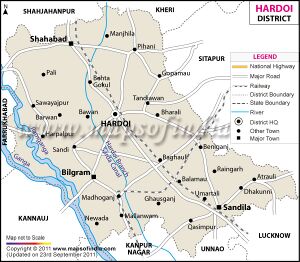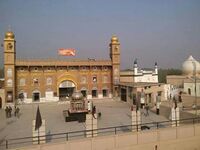Bilgram
| Author:Laxman Burdak, IFS (R) |
Bilgram (बिलग्राम) is a town in Hardoi district in the state of Uttar Pradesh, India. Bilgram was an ancient town in Kannauj region.
Contents
Variants
- Bilagrama बिलग्राम, जिला हरदोई, उ.प्र., (AS, p.630)
- Bhillagrama भिल्लग्राम = दे. Bilagramaबिलग्राम (AS, p.668)
Location
It is located at 27.18°N 80.03°E, and its average elevation is 136 metres. The Ganga River is located between Bilgarm and Kannauj. Bilgram is located on the Billahaur-Katra State Highway. Its distance from Kannauj-29 km, from Hardoi-27 km, from Kanpur - 110 km, from Lucknow - 110 km.
Jat clans
History
In the 9th or 10th century, the Raikwar King Raja Sri Ram crossed over from Kanauj and expelled the Thathera, founded the city and named it after himself as Srinagar. Muizz-Din Muhammad of Ghor who came to the area in 1193. The Muslims conquered Kanauj along with Srinagar. Srinagar was then renamed by the Muslim conquerors Bilgram after a legendary demon Bil. From here the Delhi Sultanate went on to control and dominate Oudh in 1217 under Iltutmish Shams ad-Din ibn al-Kutbi Yalam Khan (1210/1211–1236).
The two officers who conquered the region and Srinagar were the ancestors of talukdars Bilgram existed at least until the end of the 19th century. After it was made capital of a Pargana in the time of Akbar the Great, which was then ruled by Sayyid in 1000 but served with soldiers and included neighbouring Pargana Bang. A local saint killed a demon called Bel and took the name derived Belgram to Bilgram.
The ancient name of Bilgram is Srinagar, its present name Bilgram was given by some associates of Mahmud of Ghazni. The Battle of Bilgram in 1540 took place between Humayun and Sher Shah Suri. Sher Shah Suri defeated Humayun in the Battle of Bilgram.[1]
The Sadaat Bilgram are a group of Sayyid families who inhabit the historic town of Bilgram in Hardoi District. Saadat-e-Bilgram literally means the Sayyid of the town of Bilgram. These Hussaini Sayyids first migrated from Wasit, Iraq in the 13th century.[2] Their ancestor, Syed Mohammad Sughra, a Zaidi Sayyid of Iraq arrived in India during the rule of Sultan Iltutmish.
In 1217-18 the family conquered and settled in Bilgram.[3] The Sayyid commanded a Muslim army that overcame the Bhars, who were the traditional rulers of the Hardoi region, and was granted an estate centred on the town of Bilgram, where the Sayyid settled down. died in 1247, his tomb was constructed by Syed Mohammad Muhsin son of Syed Mohammad Said in 1738-39.[4]
Syed Mohammad Sughra Sixth in descent from Syed Mohammad Sughra was Syed Abdul Farah of Wasit (from him are descendants of most renowned Sayyid families in Northern India, the Barhah and Bilgram Sayyids; and in Khairabad, Fatehpur Haswa and at many other places branches of the same stem are found.[5]), who was the ancestor of the Saadat-e-Bara, another community of Sayyids.[6]
The Bilgrami Sayyid were important power brokers in the southern part of Awadh, and remained an important and influential clan, throughout the Middle Ages. They provided several taluqdar families, and were substantial landowners.[7]
Among the most notable persons of the Bilgram are Allama Azad Bilgrami (1704-1786), Syed Ali Bilgrami(1851-1911), Imad-ul-Mulk Bahadur Syed Hussain Bilgrami(1842-1926), Sursuba of Malwa and Isagarh estate Khan Bhadur Syed Ali Bahadur Bilgrami.
At present time Maulana Abid Bilgrami is an internationally known name in the field of Islamic studies.
Notable places
Bada Imam Bada Bilgram and Dargah Abbas is almost 300 years old holy sites of Shia Muslims and heritage place for visitors.
Baba Manshanath Temple is the oldest temple in town. It is the center of the main faith of the Hindu people. It has its own importance in the month of Savan. It hosts the fair in this month. Devotees come from far and wide for the worship of Lord Shankar. This temple was built by Lala Mansaram.
बिलग्राम
विजयेन्द्र कुमार माथुर[8] ने लेख किया है .....बिलग्राम (AS, p.630) हरदोई ज़िला, उत्तर प्रदेश का एक क़स्बा है। यह क़स्बा प्राचीन श्रीनगर या भिल्लग्राम नाम के नगर के खंडहरों पर बसा हुआ है। दिल्ली सल्तनत के सुल्तान इल्तुतमिश के समय में बिलग्राम पर मुस्लिमों का अधिकार हो गया था। बिलग्राम में विद्वान् मुस्लिमों की पुरानी पंरपरा रही है। इनमें से कई विद्वानों ने हिन्दी में कविताएँ भी लिखी हैं। पश्चमध्ययुगीन काल में ऐसे ही कवि मीर जलील हुए, जिन्होंने एक बरवैछंद में अपना परिचय लिखते हुए कहा है- 'बिलग्राम कौ वासी मीर जलील, तुम्हरि सरन गहि गाहै हे निधिशील।'
बिलग्राम परिचय
बिलग्राम हरदोई का एक उपखंड है, जिसके बारे में यह बताया जाता है कि यह मूल रूप से 'विलग राम' शब्द का अपभ्रंश है। 'विलग राम' अर्थात् 'राम से विलग रहने वाला'। 1909 में यहां के निवासी एक मुसलमान, सैयद हुसैन बिलग्रामी को महारानी विक्टोरिया के वादे को लागू करने के लिए व्हाइट हॉल में नियुक्त किया गया, जिन्होंने मॉर्ले मिण्टो सुधार में तथा कालान्तर में मुस्लिम लीग की स्थापना में सक्रिय भूमिका निभाई। [9]
बड़ा इमामबाड़ा बिलग्राम और दरगाह अब्बास 300 वर्ष पुराने शिया मुसलमानों के पवित्र दर्शनीय धरोहर हैं।
हरदोई का इतिहास
सैय्यद सालार मसूद ने पहला आक्रमण ईस्वी सन 1028 ईस्वी में बावन पर किया था जो हरदोई से 10 किमी पश्चिम में स्थित है। परन्तु इम्पीरियल गजेटियर का मानना है कि 1217 से पहले स्थाई मुस्लिम कब्जा इस क्षेत्र पर नहीं हो पाया था। अवध के गजेटियर के पेज 55 पर बताया गया है कि 1028 ईस्वी में सैयद सल्लर ने बावन पर कब्जा कर लिया। इसी के आस पास गोपामऊ को भी जीत लिया गया। शेखों के मुताबिक़ 1013 ईस्वी में बिलग्राम को जीत लिया। इसके बावजूद 1217 ईसवी तक नियमित रूप से मुस्लिम नियन्त्रण न हो सका। सैय्य्द शाकिर ने सबसे पहली जीत गोपामऊ पर हासिल की। हुसैनी सैय्य्दों के पूर्वज इराक के वसित शहर से 13 वीं सदी में सुलतान इल्तुतमिश के काल में भारत आए थे। 1217-18 में सैय्यद परिवार ने यहाँ के भर शासकों को हराकर बिलग्राम पर कब्जा किया और यहाँ बस गए। 1540 ई. में बिलग्राम युद्ध शेरशाह ने हुमायूँ को बिलग्राम और सांडी के बीच हराया था और वह एक बिस्ती की सहायता से गंगा पार करके बचपाया था.
External links
References
- ↑ Battle of Bilgram
- ↑ Essays in Arabic Literary Biography: 1350 - 1850, Roger M. A. Allen, Joseph Edmund Lowry, Terri DeYoung, Devin J. Stewart, Otto Harrassowitz Verlag, 30-Dec-2009
- ↑ Islam in South Asia in Practice, Barbara D. Metcalf, Princeton University Press, 08-Sep-2009
- ↑ Indian Archaeology, a Review, Archaeological Survey of India., 1979
- ↑ The imperial gazetteer of India, Volume 13, Sir William Wilson Hunter, Trübner & co., 1887
- ↑ A Gazetteer of Hardoi District Volume XLI: Gazetteers of the United Provinces edited by H. R Neville
- ↑ People of India Uttar Pradesh Volume XLII Part Three edited by A Hasan & J C Das
- ↑ Aitihasik Sthanavali by Vijayendra Kumar Mathur, p.630
- ↑ भारतकोश-बिलग्राम

